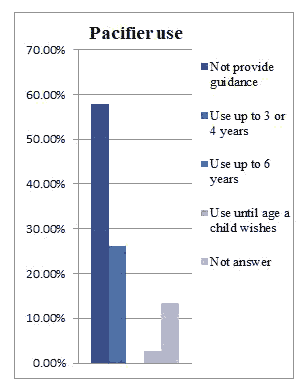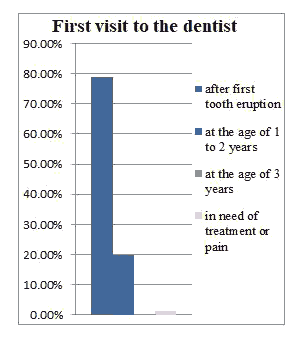Research Article - Current Pediatric Research (2021) Volume 25, Issue 10
Low knowledge of Brazilian pediatric doctors about fluoride toothpaste for children, pacifier use and child's first visit to the dentist field research.
Renato Barcellos Rédua*, Kamilla Pessanha Kunsch, Cristiane Ferreira Camargo Bazan, Jaquelini Lorenzon
Department of Pediatric Dentistry, State University of Rio de Janeiro, Rio de Janeiro, Brazil
- Corresponding Author:
- Renato Barcellos Rédua
Department of Pediatric Dentistry
State University of Rio de Janeiro
Rio de Janeiro
Brazil
E-mail: renatoredua@hotmail.com
Accepted date:25th October, 2021
Abstract
Objective: To investigate the knowledge of pediatric doctors about the prescription of toothpaste in children, about the recommendation of using a pacifier and about the recommendation of the child's first visit to the dentist Study design: Through a questionnaire approved by the national ethics committee, confidential interviews were conducted with 546 pediatric doctors through visits to private offices, hospitals and through interviews at a congress in the area. Results: The 546 pediatric doctors, only 176 voluntarily participated in the study. 35 doctors (19.9%) do not recommend fluoride toothpaste for children, 18 (10.2%) recommend only after the age of 6, 41 (23.3%) recommend only after the age of 2, 72 doctors (40.9%) recommended fluoride toothpaste since the first tooth eruption in children and 10 doctors (5.7%) did not respond. Regarding the recommendation of using a pacifier, 103 doctors (58.5%) do not provide any kind of guidance, 46 (26.1%) recommend using up to 3 or 4 years old, 4 (2.3%) recommend use until the age a child wishes and 23 (13.1%) did not answer 139 (79%) recommend that the first visit to the dentist should be after first tooth eruption, 35 (19.9%) that first visit at the age of 1 to 2 years, 2 (1.1%) only in need of treatment or pain. Conclusion: Only 40% of Brazilian pediatric doctors recommend using fluoride toothpaste since the first eruption of the baby tooth. Most doctors do not give any guidance about the use of pacifier. Most doctors recommend that first visit to the dentist should be when first tooth eruption
Keywords
Toothpastes, Pacifiers, Pediatricians.
Introduction
The scientific literature reports that the earlier the child's first visit to the pediatric dentist, the less likely it is to develop the caries disease [1-4]. Although it is recommended that children be taken to the dentist when they are one year old in order to that parents are given guidance on care related to the maintenance of your oral health, it is very most likely that a pediatrician will be the first professional health professionals to have the opportunity to address this issue a child's family [5]. Thus, it is essential that pediatricians have correct and up-to-date information on main problems that can compromise oral health of children and ways to prevent them. Caries is a common disease in early childhood and regular use fluoridated toothpaste plays a substantial role in its prevention [6,7].
The European Academy of Pediatric Dentistry (EAPD) makes recommendations and supports the use of fluoride toothpaste due to its efficiency in anti-cariogenic effects. Affirms that its use is safe through correct use supervised by parents and or guardians, which is the amount of toothpaste similar to 1 grain of rice for children up to 3 years of age, and above this age the amount similar to 1 grain of pea [8]. As well as numerous studies stand out in the prevalence of malocclusions and it is of great relevance for the execution of preventive actions and identification of these abnormalities. The pacifier suction acts as a mechanical impediment, altering the eruption of the anterior teeth, which can later cause anterior open bite, unilateral or bilateral cross bite, maxillary atresia and increased over jet [9-11]. The objective of this study is to demonstrate the importance to disseminate information about the use of fluoride toothpaste and the use of pacifiers among pediatric doctors and encourage other surveys on this topic to be done around the world.
Study Design
546 approaches were made to Brazilian pediatric doctors through visits to private practices, basic health units (UBS), hospitals, pediatric congresses and e-mail. A questionnaire composed of 3 multiple-choice questions was used, which were:
• When do you recommend fluoride toothpaste for children? Alternatives: do not recommend fluoride toothpaste for children; from the first deciduous tooth; from the age of 2 years; from the age of 6 years; none of the options.
• Do you recommend pacifier use? Alternatives: I do not issue guidance; I allow use until the age of 3 or 4 years; I allow use until the age of 6 years; allow use until the child's decision; none of the options.
• At what age does the doctor recommend the child's first visit to the dentist? Alternatives: When the first tooth erupts; aged 1 to 2 years; aged 3 years or more; in case of pain or trauma.
The inclusion criteria were pediatric doctors enrolled in the federal council of medicine and who agreed to participate and the exclusion criteria were doctors who are not specialists in pediatrics, doctors who did not agree to participate or were not regulars in the federal council of medicine. Doctors were informed that participation was voluntary and confidential by means of a free and informed consent form. Among the interviewees, 176 pediatricians agreed to participate in the research (32.2%). The study was previously approved by the local ethics and research committee.
Recommendation
The 546 pediatric doctors, only 176 (32.2%) voluntarily participated in the study. Regarding the recommendation of Brazilian pediatric doctors of fluoride toothpaste for children, 35 (19.9%) doctors do not recommend fluoride toothpaste for children, 72 doctors (40.9%) recommended fluoride toothpaste since the first tooth eruption in children, 41 (23.3%) recommend only after the age of 2, 18 (10.2%) recommend only after the age of 6 and 10 doctors (5.7%) did not respond (Figure 1).
Regarding the recommendation of using a pacifier, 103 doctors (58.5%) do not provide any kind of guidance, 46 (26.1%) recommend using up to 3 or 4 years old, 4 (2.3%) recommend use until the age a child wishes and 23 (13.1%) did not answer (Figure 2).
About first visit: 139 (79%) recommend that the first visit to the dentist should be after first tooth eruption, 35 (19.9%) that first visit at the age of 1 to 2 years, none responded from the age of 3 years and 2 (1.1%) only in need of treatment or pain (Figure 3).
Discussion
Despite the great achievements and significant improvements about health, the oral health is still a major public health problem, with emphasis on the population of low socioeconomic status, which is usually the most affected [12]. Even with a significant drop in the prevalence of caries in preschoolers in recent decades, this number is still large. Brazilian children have one of the highest rates of premature extractions due to tooth decay, resulting in a worsening of the quality of life of these [13]. We must consider as one of the causal factors of this condition the low knowledge of Brazilian pediatric doctors about the importance of fluoride dentifrice since the first deciduous tooth.
The pediatric doctor has an important role related to oral health, as it is this professional who has the first contact since birth with the child and establishes a close and continuous relationship. This imposes a fundamental role in preventing caries disease both by prescribing fluoride toothpaste and by advising on a healthy diet with low sugar levels as well as providing information about use of pacifiers and the prevention of harmful oral habits for malocclusion prevention [10,14].
A follow up study about caries prevention demonstrate that there was association between the number of dental visits and caries incidence. Children who had a smaller number of visits had higher incidence of disease during the 11 years of follow-up and 3 decades studied. A higher incidence of dental caries was associated with a longer interval between dental visits and children who had a follow-up interval greater than 12 months had an 18 times higher risk of caries compared to children with a maximum interval of 8 months [1].
Based on the results of this study, we consider the need to adopt strategies to provide for pediatric doctors more accurate information about the importance of using fluoride toothpaste on the child's since the first primary tooth and be able to provide guidance about the use of pacifier.
Conclusion
Only 40% of Brazilian pediatric doctors recommend using fluoride toothpaste since the first eruption of the baby tooth. Most doctors do not give any guidance about the use of pacifier. Most doctors recommend that first visit to the dentist should be when first tooth eruption.
References
- Redua RB, Redua PCB, Oliveira LOA. Importance of dental clinic recalls for caries prevention in children: Practice-based research. J Clin Pediatr Dent 2019; 43(6): 376-81.
- Edelstein BL. Evidence-based dental care for children and the age 1 dental visit. Pediatr Ann 1998; 27(9): 569-74.
- Feldens CA, Vitolo MR, Drachler ML. A randomized trial of the effectiveness of home visits in preventing early childhood caries. Community Dent Oral Epidemiol 2007; 35(3): 215-23.
- Abanto J, Celiberti P, Braga MM, et al. Effectiveness of a preventive program based on caries risk assessment and recall intervals on the incidence and regression of initial caries lesions in children. Int J Paediatr Dent 2015; 25(4): 291-9.
- American academy of pediatric dentistry, Clinical affairs committee-infant oral health Subcommittee. Guideline on infant oral health care. Pediatr Dent 2012; 34(5): e148-52.
- Kottayi S, Bhat SS, Hegde KS, et al. A cross-sectional study of the prevalence of dental caries among 12- to 15-year-old overweight schoolchildren. J Contemp Dent Pract 2016; 17(9): 750-54.
- Santos APP, Nadanovsky P, Oliveira BH. A systematic review and meta-analysis of the effects of fluoride toothpastes on the prevention of dental caries in the primary dentition of preschool children. Community Dent Oral Epidemiol 2013; 41(1): 1-12.
- Toumba KJ, Twetman S, Splieth C, et al. Guidelines on the use of fluoride for caries prevention in children: an updated EAPD policy document. Eur Arch Paediatr Dent 2019; 20(6): 507-16.
- Costa CTD, Shqair AQ, Azevedo MS, et al. Pacifier use modifies the association between breastfeeding and malocclusion: a cross-sectional study. Braz Oral Res 2018; 32: e101.
- Perez-Suarez V, Carrillo-Diaz M, Crego A, et al. Maternal education, dental visits and age of pacifier withdrawal: pediatric dentist role in malocclusion prevention. J Clin Pediatr Dent 2013; 37(3): 315-9.
- Scavone H, Ferreira RI, Mendes TE, et al. Prevalence of posterior crossbite among pacifier users: A study in the deciduous dentition. Braz Oral Res 2007; 21(2): 153-8.
- Bader JD, Rozier RG, Lohr KN, et al. Physicians' roles in preventing dental caries in preschool children: A summary of the evidence for the US preventive services task force. Am J Prev Med 2004; 26(4): 315-25.
- Gradella CM, Bernabe E, Bonecker M, et al. Caries prevalence and severity, and quality of life in Brazilian 2- to 4-year-old children. Community Dent Oral Epidemiol 2011; 39(6): 498-504.
- Soares RC, Rosa SV, Moyses ST, et al. Methods for prevention of early childhood caries: Overview of systematic reviews. Int J Paediatr Dent 2021; 31(3): 394-421.


